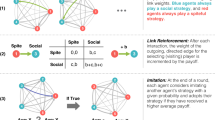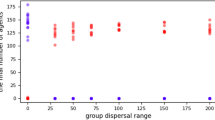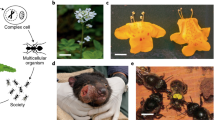Abstract
AN individual behaves spitefully when it harms itself in order to harm another individual more1. Hamilton1,2 predicted that spite may evolve if it is expressed only in those encounters that occur between individuals of less than average relatedness. More recently Verner3 suggested that territory size may become super-optimal because of a selective advantage arising from the spiteful exclusion of others from limited resources. His model is essentially different from Hamilton's in that spite is directed at individuals indiscriminately with respect to relatedness. Recently Rothstein4 has shown analytically that the initial spread of spiteful traits will be very slow in all but the smallest populations. He also argued verbally that indiscriminate spite can never be evolutionarily stable even if it should spread (see also Davies5). The question of evolutionary stability is clearly important, but its resolution requires an analytical approach. We report here an approach based on Maynard Smith's6 concept of the evolutionarily stable strategy (ESS), a strategy which, when common, does better than any alternative strategy played by a rare mutant. We show that spite can be an ESS, but that the magnitude of spite will be small in large populations.
This is a preview of subscription content, access via your institution
Access options
Subscribe to this journal
Receive 51 print issues and online access
$199.00 per year
only $3.90 per issue
Buy this article
- Purchase on Springer Link
- Instant access to full article PDF
Prices may be subject to local taxes which are calculated during checkout
Similar content being viewed by others
References
Hamilton, W. D. Nature 228, 1218–1220 (1970).
Hamilton, W. D. in Man and Beast: Comparative Social Behavior (eds Eisenberg, J. F. & Dillon, W. S.) 59–91 (Smithsonian Institution Press, Washington, D. C., 1971).
Verner, J. Am. Nat. 111, 769–775 (1977).
Rothstein, S. I. Am. Nat. 113, 317–333 (1979).
Davies, N. B. in Behavioural Ecology: An Evolutionary Approach (eds Krebs, J. R. & Davies, N. B.) 317–350 (1978).
Maynard Smith, J. & Price, G. R. Nature 246, 15–18 (1973).
Parker, G. A. & Macnair, M. R. Anim. Behav. 26, 97–110 (1978).
Author information
Authors and Affiliations
Rights and permissions
About this article
Cite this article
KNOWLTON, N., PARKER, G. An evolutionarily stable strategy approach to indiscriminate spite. Nature 279, 419–421 (1979). https://doi.org/10.1038/279419a0
Received:
Accepted:
Published:
Issue Date:
DOI: https://doi.org/10.1038/279419a0
This article is cited by
-
Recent trends in evolutionary ethics: greenbeards!
Biology & Philosophy (2018)
-
Effect of competitor abundance on feeding territoriality in a grazing fish, the ayu Plecoglossus altivelis
Ecological Research (1996)
-
Egg cannibalism by sticklebacks: spite or selfishness?
Behavioral Ecology and Sociobiology (1992)
-
Determinants and evolutionary consequences of dominance among female gelada baboons
Behavioral Ecology and Sociobiology (1980)
Comments
By submitting a comment you agree to abide by our Terms and Community Guidelines. If you find something abusive or that does not comply with our terms or guidelines please flag it as inappropriate.



